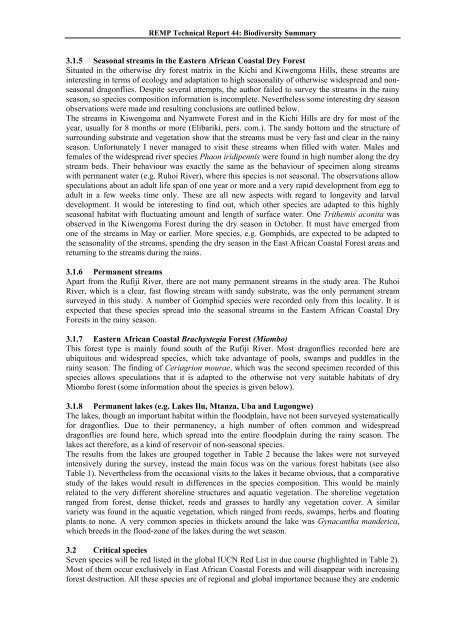Family / Scientific name - Coastal Forests of Kenya and Tanzania
Family / Scientific name - Coastal Forests of Kenya and Tanzania
Family / Scientific name - Coastal Forests of Kenya and Tanzania
Create successful ePaper yourself
Turn your PDF publications into a flip-book with our unique Google optimized e-Paper software.
REMP Technical Report 44: Biodiversity Summary<br />
3.1.5 Seasonal streams in the Eastern African <strong>Coastal</strong> Dry Forest<br />
Situated in the otherwise dry forest matrix in the Kichi <strong>and</strong> Kiwengoma Hills, these streams are<br />
interesting in terms <strong>of</strong> ecology <strong>and</strong> adaptation to high seasonality <strong>of</strong> otherwise widespread <strong>and</strong> nonseasonal<br />
dragonflies. Despite several attempts, the author failed to survey the streams in the rainy<br />
season, so species composition information is incomplete. Nevertheless some interesting dry season<br />
observations were made <strong>and</strong> resulting conclusions are outlined below.<br />
The streams in Kiwengoma <strong>and</strong> Nyamwete Forest <strong>and</strong> in the Kichi Hills are dry for most <strong>of</strong> the<br />
year, usually for 8 months or more (Elibariki, pers. com.). The s<strong>and</strong>y bottom <strong>and</strong> the structure <strong>of</strong><br />
surrounding substrate <strong>and</strong> vegetation show that the streams must be very fast <strong>and</strong> clear in the rainy<br />
season. Unfortunately I never managed to visit these streams when filled with water. Males <strong>and</strong><br />
females <strong>of</strong> the widespread river species Phaon iridipennis were found in high number along the dry<br />
stream beds. Their behaviour was exactly the same as the behaviour <strong>of</strong> specimen along streams<br />
with permanent water (e.g. Ruhoi River), where this species is not seasonal. The observations allow<br />
speculations about an adult life span <strong>of</strong> one year or more <strong>and</strong> a very rapid development from egg to<br />
adult in a few weeks time only. These are all new aspects with regard to longevity <strong>and</strong> larval<br />
development. It would be interesting to find out, which other species are adapted to this highly<br />
seasonal habitat with fluctuating amount <strong>and</strong> length <strong>of</strong> surface water. One Trithemis aconita was<br />
observed in the Kiwengoma Forest during the dry season in October. It must have emerged from<br />
one <strong>of</strong> the streams in May or earlier. More species, e.g. Gomphids, are expected to be adapted to<br />
the seasonality <strong>of</strong> the streams, spending the dry season in the East African <strong>Coastal</strong> Forest areas <strong>and</strong><br />
returning to the streams during the rains.<br />
3.1.6 Permanent streams<br />
Apart from the Rufiji River, there are not many permanent streams in the study area. The Ruhoi<br />
River, which is a clear, fast flowing stream with s<strong>and</strong>y substrate, was the only permanent stream<br />
surveyed in this study. A number <strong>of</strong> Gomphid species were recorded only from this locality. It is<br />
expected that these species spread into the seasonal streams in the Eastern African <strong>Coastal</strong> Dry<br />
<strong>Forests</strong> in the rainy season.<br />
3.1.7 Eastern African <strong>Coastal</strong> Brachystegia Forest (Miombo)<br />
This forest type is mainly found south <strong>of</strong> the Rufiji River. Most dragonflies recorded here are<br />
ubiquitous <strong>and</strong> widespread species, which take advantage <strong>of</strong> pools, swamps <strong>and</strong> puddles in the<br />
rainy season. The finding <strong>of</strong> Ceriagrion mourae, which was the second specimen recorded <strong>of</strong> this<br />
species allows speculations that it is adapted to the otherwise not very suitable habitats <strong>of</strong> dry<br />
Miombo forest (some information about the species is given below).<br />
3.1.8 Permanent lakes (e.g. Lakes Ilu, Mtanza, Uba <strong>and</strong> Lugongwe)<br />
The lakes, though an important habitat within the floodplain, have not been surveyed systematically<br />
for dragonflies. Due to their permanency, a high number <strong>of</strong> <strong>of</strong>ten common <strong>and</strong> widespread<br />
dragonflies are found here, which spread into the entire floodplain during the rainy season. The<br />
lakes act therefore, as a kind <strong>of</strong> reservoir <strong>of</strong> non-seasonal species.<br />
The results from the lakes are grouped together in Table 2 because the lakes were not surveyed<br />
intensively during the survey, instead the main focus was on the various forest habitats (see also<br />
Table 1). Nevertheless from the occasional visits to the lakes it became obvious, that a comparative<br />
study <strong>of</strong> the lakes would result in differences in the species composition. This would be mainly<br />
related to the very different shoreline structures <strong>and</strong> aquatic vegetation. The shoreline vegetation<br />
ranged from forest, dense thicket, reeds <strong>and</strong> grasses to hardly any vegetation cover. A similar<br />
variety was found in the aquatic vegetation, which ranged from reeds, swamps, herbs <strong>and</strong> floating<br />
plants to none. A very common species in thickets around the lake was Gynacantha m<strong>and</strong>erica,<br />
which breeds in the flood-zone <strong>of</strong> the lakes during the wet season.<br />
3.2 Critical species<br />
Seven species will be red listed in the global IUCN Red List in due course (highlighted in Table 2).<br />
Most <strong>of</strong> them occur exclusively in East African <strong>Coastal</strong> <strong>Forests</strong> <strong>and</strong> will disappear with increasing<br />
forest destruction. All these species are <strong>of</strong> regional <strong>and</strong> global importance because they are endemic

















